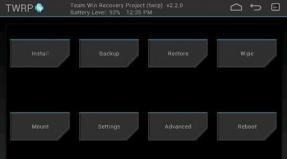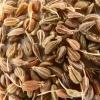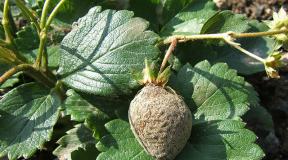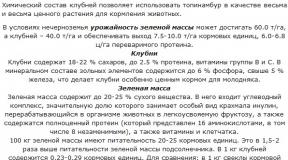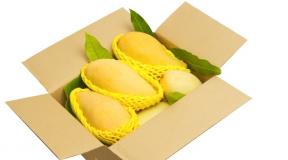Tablets for quickly lowering blood sugar. Medicines to lower blood sugar.
A low-carbohydrate diet and active physical activity help to stabilize the level of glycemia in patients with type II diabetes mellitus. If these measures are not enough, patients are prescribed medications to reduce high sugar in blood serum. Drug treatment helps to normalize metabolism, increases the resistance of peripheral tissues to the hormone insulin, and stimulates the pancreas.
Sulfonylurea derivatives
Tablets of this group activate the receptors of β-cells of the pancreas, the release of reserve reserves of insulin occurs. Sulfonylurea derivatives increase tissue resistance to protein hormone. Most of the insulin is released after a meal.
New generation tablets for effective reduction of high serum sugar in non-insulin dependent type 2 diabetes, list of drugs:
- Glibenclamide is a second generation sulfonylurea derivative with hypoglycemic and hypocholesterolemic effects. The drug stimulates the work of the islets of Langerhans, increases the resistance of peripheral tissues to insulin, improves the utilization of glucose from the muscles and liver. The drug lowers the level of bad cholesterol, reduces the urge to urinate, and prevents the formation of blood clots. The action of the drug lasts 8-12 hours. The dosage is selected individually.
- Gliclazide is effective for metabolic disorders, latent diabetes in patients with exogenous obesity. A decrease in hyperglycemia is achieved by stimulating the β-cells of the pancreas, accelerating the utilization of excess glucose. The drug Gliclazide, which lowers blood sugar, overweight with diabetes mellitus 2 types, protect against the development of cataracts, nephropathy, thrombus formation. The drug is used as monotherapy and in combination with insulin injections or other sugar-reducing tablets.
- Another new generation drug for lowering serum sugar in type 2 diabetes is Gliquidone, this agent stimulates the pancreatic islets, causing a reserve release of insulin. In addition, the tablets increase the sensitivity of tissues to the hormone, lower the level of glucagon. Gliquidone therapy is performed in middle-aged and elderly people.
Sulfonylurea derivatives have contraindications for use and may have side effects. Therefore, the drugs and dosage are selected by the attending physician, taking into account the individual characteristics and severity of the disease.
DPP-4 inhibitors
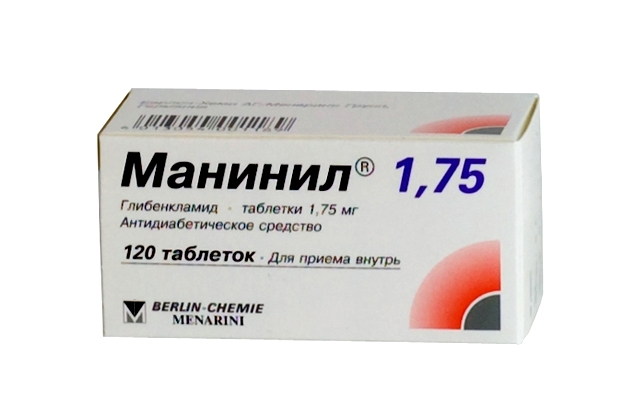
A group of dipeptidyl peptidase inhibitors stimulate insulin production, reduce glucagon levels, prevent the depletion of pancreatic reserves, and inhibit liver glucogenesis. Unlike other pills, DPP-4 inhibitors help reduce excess weight in type 2 diabetes. The drugs slow down the emptying of the stomach, thereby reducing appetite. The tablets help to cope with carbohydrate addiction and reduce excess body weight.
The medicine can be used in combination with other sugar-lowering tablets or insulin.
DPP-4 inhibitors are approved for use in elderly patients with cardiac dysfunction, circulatory system, kidney suffering from hypertension.
Name of high blood sugar pills:
- Galvus stimulates the islets of the pancreas, reduces the production of glucagon. The drug acts on the receptors of the β-cells of the pancreas, improving their functioning. Galvus therapy leads to a decrease in low density lipoproteins. At complex treatment the level of glycated hemoglobin decreases, excess body weight decreases.
- Januvia is a blood sugar lowering drug with hypoglycemic properties in type 2 diabetes. The drug works only when the glycemic level is increased and has no effect on normal performance sugar, is used for monotherapy and in combination with other medicines or insulin. Januvia reduces appetite, helps to lose weight.
- An effective drug for lowering serum sugar is Onglisa, after taking this drug, the level of hormones that stimulate the production of insulin increases. Treatment reduces the concentration of glucagon, improves the functioning of the islets of the pancreas. Thanks to this action, patients can control the level of glycemic parameters after eating. The drug reduces appetite, excess weight. Ongiasis is prescribed as monotherapy and is combined with Metformin.
Meglitinids

Meglitinides are medicines used to lower blood sugar. According to the method of action, the drugs are similar to sulfonylurea derivatives, they stimulate the release of reserve insulin from the pancreatic cells, and are able to reduce hyperglycemia after eating.
List of pills that lower serum sugar for elevated level glycemia:
- Novonorm stimulates the secretion of the protein hormone by β-cells. It is effective to take the medicine after a meal, which allows patients to follow a less restrictive diet. Novonorm is prescribed if diet therapy and physical exercise did not give any result. The drug is used alone or together with Metformin.
- Starlix is a pill of the meglitinide group that lowers blood sugar in type 2 diabetes. The decrease in hyperglycemia occurs due to the increase in the production of insulin by the islets of the pancreas and the improvement of the susceptibility of body tissues to the protein hormone. The maximum accumulation of the active substance in the body is observed 1 hour after oral administration of the drug, the duration of action is 4 hours. For the treatment of non-insulin-dependent diabetes mellitus, monotherapy or complex prescription of sugar-lowering drugs is carried out.
Alpha glucosidase inhibitors
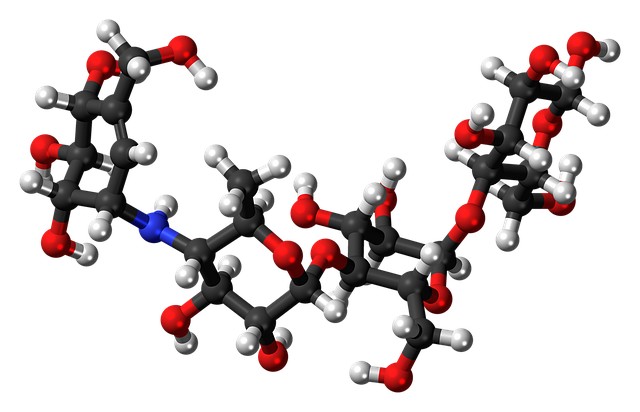
How can you quickly lower blood sugar, which pills are the safest and most effective? Tablets of the alpha-glucosidase inhibitor class help to reduce the level of hyperglycemia. These drugs lower sugar by slowing the absorption of complex carbohydrates by the small intestine.
Drugs used to lower high blood sugar include:
- Glucobay acts after a meal, regulates the absorption of carbohydrates in the intestine, and allows you to control daily fluctuations in glycemia. It is prescribed for the treatment of type 1 and 2 diabetes as part of complex therapy.
- A drug that lowers blood sugar, Miglitol inhibits the breakdown and absorption of carbohydrates by the walls small intestine... Reduces the level of glycemia after meals, improves lipid metabolism, and promotes weight loss. The drug is taken on an empty stomach, combined with other sugar-reducing tablets.
- Voxid is a medication that lowers serum sugar in type 2 diabetes. The tablets cause inhibition of α-glucosidases, which leads to a delayed breakdown of food and absorption of glucose into the systemic circulation. As a result, glycemia decreases after a meal. Voxid has local action, is not absorbed into the bloodstream and is excreted along with the feces.
Medications that increase blood sugar

Patients with diabetes mellitus often have concomitant pathologies of the cardiovascular system. Therapy cardiac diseases can be carried out with drugs that increase serum sugar and reduce the resistance of body tissues to insulin. Therefore, before starting treatment, it is necessary to inform the doctor about the presence of diabetes mellitus in order to choose the right medication.
What drugs and medications increase blood sugar?
- Anaprilin;
- Bisoprolol;
- Talinolol;
- Diuretics: Oxodolin, Ezidrex, Chlorthalidone;
- Verapamil;
- Nifedipine;
- Hypnotic barbiturates;
- Antibiotic Doxycycline;
- Hormonal drugs.
How can you, which diabetes medications that lower hyperglycemia should you use? The attending physician should prescribe medications. When prescribing therapy, a set of drugs and measures is selected that will lead to the normalization of glycemia, allow monitoring the patient's condition, and reduce the likelihood of complications.
As you know, insulin is produced in sufficient quantities, but its glucose-lowering ability is reduced. The pharmaceutical industry around the world today produces many tablet preparations that correct this flaw in the metabolism.
At the present time, a few are known enough proven ways to lower blood sugar with type 2 diabetes mellitus.
- The first, well-known, is strict adherence to the diet: limiting carbohydrate foods, excluding easily digestible carbohydrates (foods containing sweets) from the diet, and limiting fats. The calorie content of the daily diet should be either physiological, or reduced, subcaloric (1 800 - 2000 kcal.) - with excessive body weight.
- The second, also known to you way - increased motor activity(gymnastics, running, walking, outdoor games, physical labor).
- The third method is the use of decoctions and infusions of medicinal herbs. In central Europe, there are about 60 species of herbs that have a hypoglycemic effect.
- The fourth way is application tableted antihyperglycemic drugs.
In the mid-1990s, three groups of such drugs were known: sulfonylureas, biguanides, and drugs that interfere with the absorption of glucose in the intestine.
1. SULPHANYLUREA PREPARATIONS
They are most widely used in the treatment of type 2 diabetes mellitus. They act in three ways:
- the first and most powerful effect is to increase insulin formation and release B cells of the pancreas;
- second therapeutic effect - reduce the reserve deposits of glucose in the liver;
- the third - increase the peripheral efficiency of insulin, enhancing its effect on target cells of all insulin-dependent tissues.
For a long time, only the first generation of sulfonylureas (groups of tolbutamide, carbutamide and chlorpropamide) were at the disposal of diabetic patients. To obtain a hypoglycemic effect, their daily dose was large, from 0.5 to 2 grams. In recent years, they have found widespread use second generation sulfonylurea preparations(see table), which surpass the first generation by about 100 times in terms of the hypoglycemic effect. Accordingly, the daily dose of drugs is reduced and, consequently, the degree of undesirable side effects from their use.
Most of the second generation drugs work 12 hours, therefore, they are taken twice a day, morning and evening. This is usually 0.5 ~ 1 tablet before or after meals, as directed by your healthcare professional. Sometimes they are taken three times a day (morning, afternoon and evening) to get a smoother decrease in blood sugar.
Some second-generation drugs have additional medicinal properties ... For example, gliclazide and glidiazinamide protect the vessels of the microvasculature, reducing the ability of platelets to form clots, they change the permeability of the smallest capillary vessels, and reduce the level of fat fractions that contribute to the development of atherosclerosis. Both drugs practically do not cause hypoglycemia, but their hypoglycemic effect is weaker than that of glibenclamide or glisoxepide.
All sulfonylurea preparations, regardless of generation in case of overdose (due to their ability to increase insulin secretion) increase appetite and can lead to obesity... Patients should remember this property and adhere to the recommended diet, be treated with minimally effective doses of antihyperglycemic drugs, regularly controlling your weight and blood glucose levels... Neglecting these tips leads to undesirable consequences: increase in body weight, progression of atherosclerosis and subsequently - to the development resistance to hypoglycemic drugs... Resistance is addiction, when the sugar-lowering effect of the drug is individually reduced in the patient. And then the blood sugar level rises despite taking a lot of pills.
A common negative effect these drugs are the ability to dramatically reduce blood sugar levels, cause hypoglycemic reactions. Severe hypoglycemia can be caused by drugs of the chlorpropamide and glibenclamide groups. If you are taking any of these drugs, be especially careful about the dosages, in any case do not increase the dose without consulting your doctor.
remember, that promote the development of hypoglycemia can situations such as fasting, alcohol intake, exercise, taking aspirin or sulfa antimicrobial drugs (etazole, sulfodimezine) and some other drugs. Therefore, if you are prescribed any other medicine, except for tableted antihyperglycemic drugs, check with your doctor. possible effects their interaction to avoid hypoglycemia.
Diseases of the kidneys and liver can provoke hypoglycemia. The first signs of hypoglycemia are: mood swings, headache, severe weakness, hunger, palpitations, blurred consciousness. IN initial stage this is easily eliminated by taking sweets (sugar, honey, jam). Subsequently, when the patient can lose consciousness, only intravenous administration glucose. Therefore, if symptoms of hypoglycemia appear, hurry up to eat sweets and coordinate your further behavior over the phone with your doctor. The hypoglycemic state is especially dangerous in patients with ischemic disease heart, atherosclerosis of the cerebral vessels, since hypoglycemia can easily provoke myocardial infarction or stroke in them. Hypoglycemia can cause high blood pressure and bleeding in the eye, resulting in sudden blindness.
Most hypoglycemic drugs excreted from the body by the kidneys and liver, therefore, they are usually not prescribed for chronic diseases of these organs. The exception is glurenorm, which is 95% excreted from the body through the intestines.
In rare cases, from the use of sulfonylurea preparations there are allergies, manifested by itching, hives, swelling of the skin. Sometimes they cause nausea, pain in the epigastric region, in the right hypochondrium, cholestasis, intestinal dysbiosis, constipation, even less often - a toxic effect on the blood (a drop in the number of leukocytes, platelets). Therefore, a patient taking sulfonylurea preparations should from time to time do blood tests... If you experience any symptoms of side effects, you should immediately consult a doctor.
2. BIGUANIDES
They apply much less often due to numerous side effects and contraindications.
Biguanides should not be taken:
- people of older age groups (60 years and more),
- in the presence of any hypoxia (these are chronic diseases of the heart, brain),
- in the presence of chronic diseases of the liver and kidneys,
- any acute surgical, infectious and inflammatory diseases.
Biguanides often give nausea, a metallic taste in the mouth, diarrhea, bloating, and discomfort in the right hypochondrium. Urticaria, itchy skin, rash may develop. If you experience these symptoms, be sure to talk to your doctor.
But along with the negative properties of biguanides, there are also positive ones: they do not affect insulin secretion, i.e. do not enhance it; they promote the utilization of glucose in tissues, enhancing the action of their insulin or injected. Therefore, β-cells do not overexert themselves and do not deplete their insulin stores. Normalization of insulin secretion leads in turn to decreased appetite... It is very beneficial for type 2 diabetes mellitus at the onset of the disease with overproduction of insulin and overweight. In addition, biguanides reduce intestinal absorption of glucose and normalize the level of lipid fractions in the blood, preventing the processes of atherosclerosis. In view of the above, biguanides are often prescribed to persons with a short history of type II diabetes, who are overweight, but do not suffer from concomitant diseases.
All biguanide preparations with the "retard" prefix work longer than the usual ones with the same name. Take biguanides always after eating, simple - three times a day, prolonged - twice a day (morning and evening). They can be applied for weight loss and obese persons even without diabetes.
3. DRUGS THAT INTERPRETE THE ABSORPTION OF GLUCOSE IN THE INTESTINAL
Perhaps this is the least known and least used group of antihyperglycemic drugs in our country. Guarem and acarbose are produced in Finland and Germany. They have not yet been purchased by the CIS republics, as they are quite expensive.
Glucobay(manufacturer - Bayer, Germany) is currently undergoing clinical trials in the endocrinology department of the 10th clinical hospital Minsk. Apparently, this group of drugs is very promising due to the absence of any significant side effects and the possibility of using it in patients regardless of the type of diabetes mellitus. They can be used together with sulfonylureas, biguanides or insulin, since they only interfere with the absorption of glucose in the intestine and do not alter the synthesis and secretion of their own insulin.
Table. Sugar-lowering tablet preparations
| Drug names | Action time in hours | Producing countries | |||
| International | Commercial | ||||
| Drugs sulfanyl- urea | I rest indolence | Tolbutamide Carbutamide Chlorpropamide | Butamid, Orabet, Rustinone, Diabetol, Tolbusal, Orinaza Bukarban, Oranil and others Diabenez, Prodiaben, Chlorpropamide | 6-12 | Germany, USA, CIS Hungary, Germany USA, Germany, CIS |
| II rest indolence | Glibenclamide Glibornuride | Euglucon, Glyburide, Maninil, Daonil, Glinil, Glibetik Glurenorm Diamicron, Diabeton, Predian | 8-12 | Germany, Yugoslavia, Austria, India, Israel Germany Finland, Canada, Germany, Austria France, Yugoslavia |
|
| Biguanides | Buformin Metformin | Silubin, Adebit, Glibutid, Buformin Silubin-retard, Buformin-retard | 6-8 | Germany, Hungary, CIS, Yugoslavia | |
| Glucophage, Glyformin Glucophage retard | 6-8 | France, CIS, Finland | |||
Gennady KOZYUK, Candidate of Medical Sciences.
The journal "Diabetic", No. 1-2, 1995.
During type II diabetes mellitus, impaired insulin secretion or peripheral insulin resistance appears. This is chronic illness, most often progresses regardless of treatment methods, can cause various pathologies of vital organs. Insulin resistance is the ineffective biological response of cells to the action of insulin, although its concentration meets physiological norms.
Tactics taken medical measures on drug treatment heading for normalization biological processes underlying the disease. Achieved a decrease in insulin resistance, improves the function of β-cells.

One of the main conditions successful treatment ailment is the earliest possible detection of pathologies. Modern diagnostics allows you to identify deviations at the stage of violation of the correct reaction of cells to an increase in blood glucose.

After the diagnosis is made, aggressive therapy is used, which makes it possible to achieve target glycemic values in the shortest possible time. Both mono- and combination therapy can be used, the specific decision is made by the attending physician, depending on the stage and characteristics of the course of the disease.
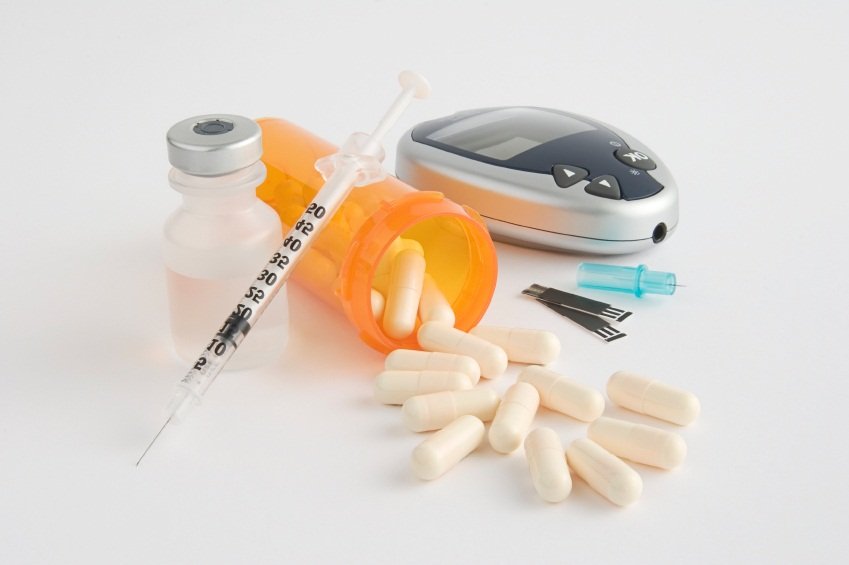
After the next medical examinations, based on the analyzes received, the technique can be adjusted. In addition, if necessary, insulin therapy is performed, due to which disruptions of carbohydrate metabolism are compensated.
Indicators for the appointment of drug therapy, drug groups
After the start of taking medications, the likelihood of spontaneous recovery of insulin secretion in normalized values is significantly minimized, in most cases the gland completely atrophies. After the diagnosis is made, early stages dietary measures, increased physical activity and lifestyle changes are being tested. Only if attempts to cure the ailment by these methods proved to be ineffective, drug therapy is prescribed.
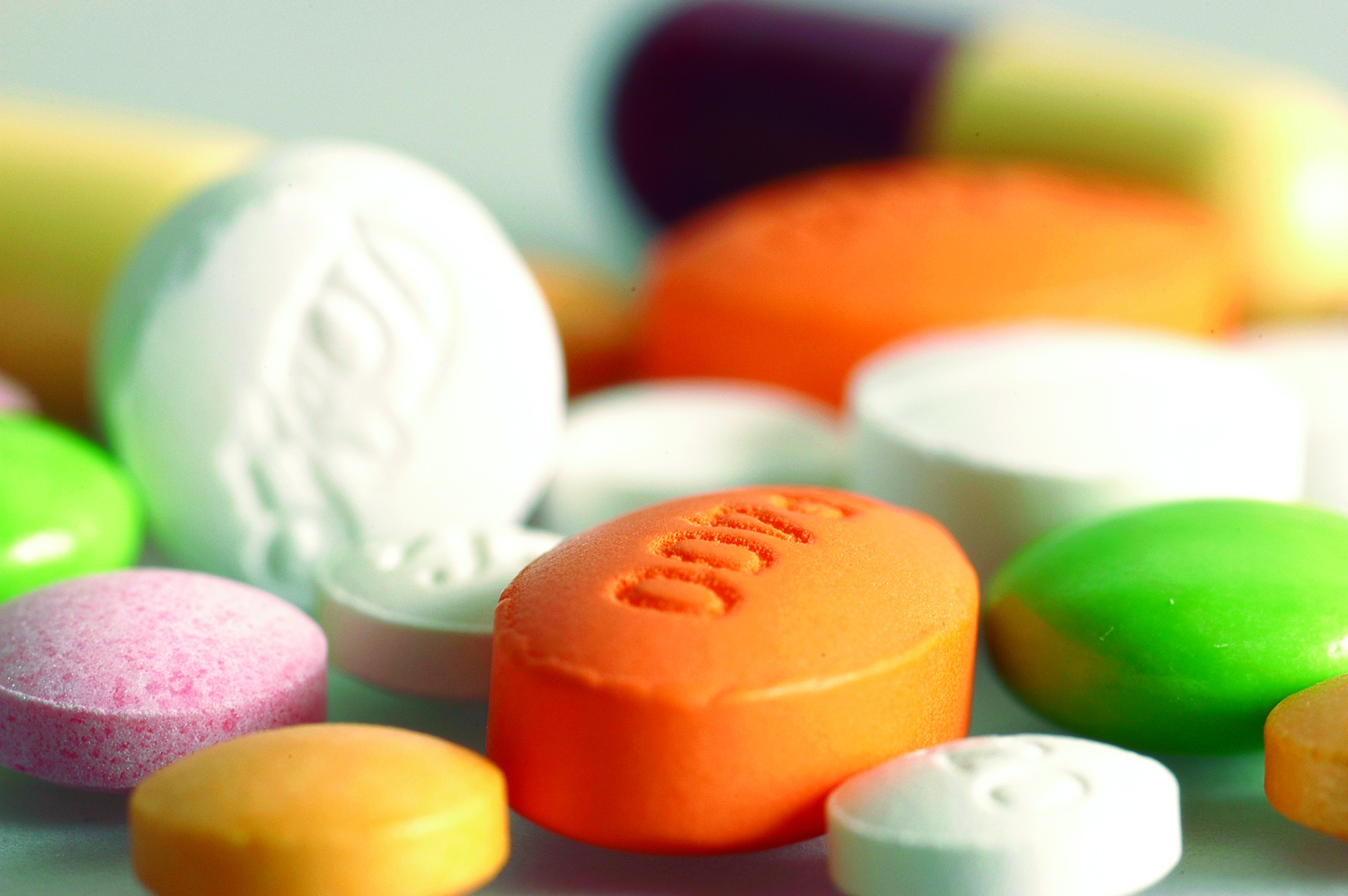
Oral medications are divided into three types.
| Medication | Description |
|---|---|
| Secretogens | They are able to significantly increase the secretion of insulin, the optimal concentrations in the blood are selected by changing the dose. In terms of time, the effect can be short or prolonged. The first group includes clays, the second group includes sulfonylurea derivatives. |
| Active substances that reduce insulin resistance restore the cells' ability to adequately respond to insulin in the blood | The active substance is thiazolidinediones and biguanides. |
| Inadmissible intestinal absorption of glucose | It does not enter the bloodstream and is naturally excreted from the body. This group of medications includes α-glucosidase inhibitors. |
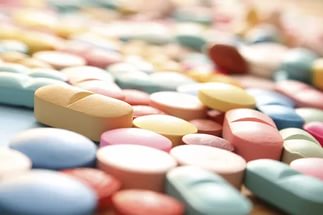
Prescribing specific drugs can only be carried out after a correct diagnosis has been made. The action of active substances should correspond to the cause of type 2 diabetes mellitus and should be aimed at eliminating it. A list of the most commonly used drugs is provided.
Secretogens (insulin stimulants)
Very popular medicines, made on the basis of sulfonylurea, differ in different efficacy and absorption rate. A strict dosage is required, overdose can cause hypoglycemia. This is a pathological condition caused by a sharp decrease in the concentration of glucose in the blood. Mild stages are characterized by pallor of the skin, sweating, and increased heartbeat. In severe forms, confusion of consciousness, speech disorders, loss of movement and orientation appear. The patient may fall into a coma.

Pancreatic beta cells are stimulated active ingredient, which leads to an increase in insulin secretion. The duration of action is limited by the viability of the cells.
- Advantages. Have a pronounced healing effect, reduce HbA1C by 2%, stimulate the early peak of secretion. Only potassium channels are blocked. Patients taking such medications can be in the stage coronary syndrome do not convert to insulin.
- Flaws. During the reception, an aggravated feeling of hunger appears, the patient's weight increases at an accelerated rate.
Contraindications include pregnancy and breastfeeding, apparent deficiency of beta cells, atrophy of thyroid function.
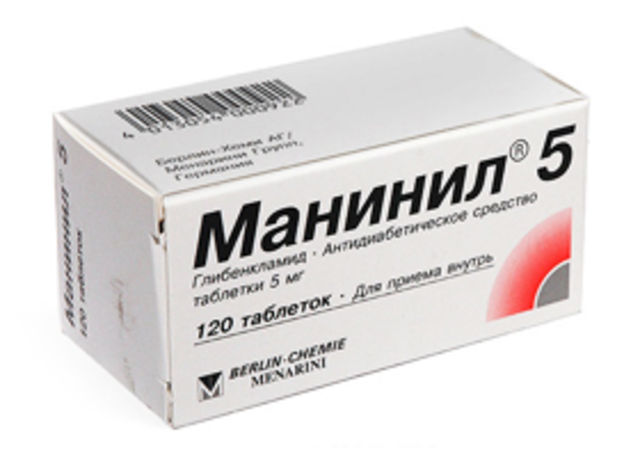
A modern drug, belongs to the second generation, has a pronounced sugar-reducing effect. It is metabolized by liver cells, does not have a negative effect on the kidneys. The maximum daily dose cannot exceed 20 mg, for the elderly, the dose is reduced to 10 mg. The tablets are taken twice a day, the dose is adjusted according to the severity of the disease. The effect is assessed after 4 weeks of continuous use, if the positive changes are not enough, then you should switch to the combined treatment.
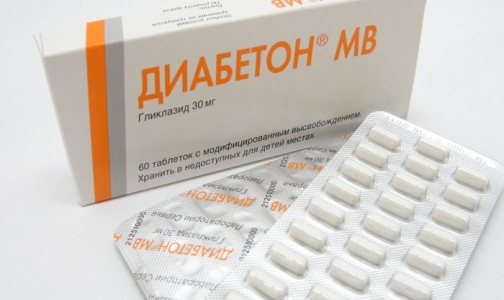
It is in second place in terms of frequency of administration, simulates an early maximum of insulin secretion, can not only lower blood sugar levels, but also improve its rheological parameters. It has a positive effect on blood supply, prevents the development of pathologies of the retina, and exhibits antioxidant properties. Depending on the stage of the disease, it can be applied once or twice a day. The first effect is determined a week after the start of admission; an increase in the daily dose is allowed only after a urine and blood test. The maximum intake cannot exceed 320 mg / day.
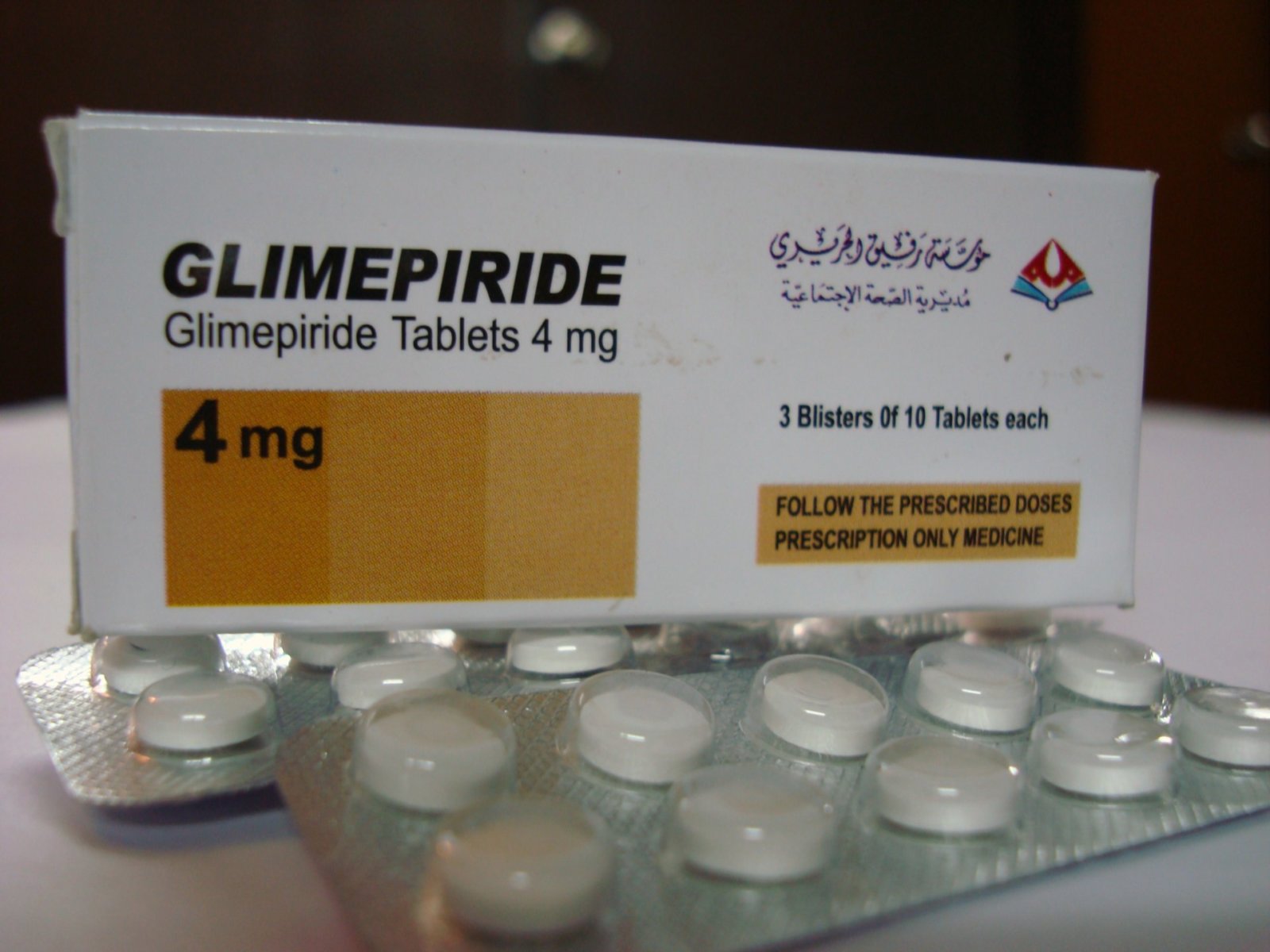
It belongs to the third generation drugs, releases insulin within 24 hours, can be prescribed for myocardial infarction. After ingestion, it does not accumulate in the body, it is excreted in urine and feces. It is taken once a day, the step of the degree and the initial dose is 1 mg. Evaluation of the effectiveness of the action is carried out after a week of treatment, changes in the amount of the prescribed drug are allowed only after the analysis of urine and blood. When switching to another drug, the exact relationship between doses of different drugs cannot be determined.
Alpha glucosidase inhibitors

In our country, from a large family of these effective drugs only one product has passed state registration - acarbose. Acarbose acts as a filter that prevents complex carbohydrates from being absorbed into the bloodstream. It binds to an enzyme small intestine and does not allow it to break down complex polysaccharides. Thus, the development of hyperglycemia is prevented.
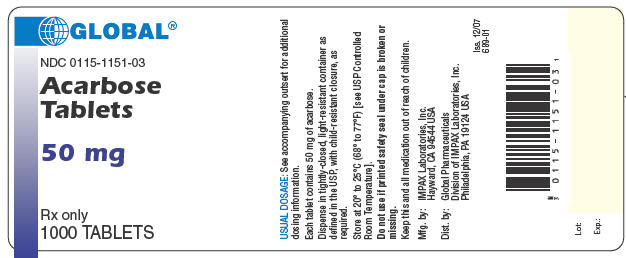
Acarbose - tablets
- Advantages. Does not affect the level of glucose, does not stimulate its production. It has a positive effect on body weight, the patient begins to moderately lose excess weight. The effect is achieved due to the fact that a much smaller amount of high-calorie glucose enters the body. In practice, it has been proven that as a result of prolonged use of acarbose, the progress of vascular atherosclerosis is significantly slowed down, they increase their permeability, and the function of smooth muscles of the capillary walls improves. The drug is not absorbed into the bloodstream, which excludes the occurrence of pathologies of internal organs.
- Flaws. In the intestines, fermentation begins due to the large amount of carbohydrates not processed by enzymes, which can cause bloating and diarrhea. The effectiveness of the drug is much less than that of metformin and sulfonylurea derivatives.
It is forbidden to take patients with cirrhosis of the liver, various inflammation of the intestines, renal failure, pregnant and lactating mothers. There are almost no side effects.
It is taken before meals, the initial dose is three times 50 mg each. After 4 weeks of taking the drug, a break should be taken in treatment.
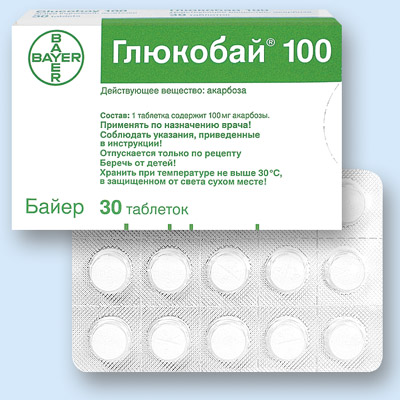
Pseudotetrasaccharide of microbial origin, affects the amount of absorbed glucose, stabilizes its parameters in the blood during the day. The maximum concentration occurs 2 hours after ingestion, is excreted by the intestines (50%) and kidneys (50%). The effectiveness is checked after 4 weeks of drug therapy, according to the indicators, the daily dose can be increased to 200 mg three times a day. Joint application with adsorbents is not recommended.

It is an inhibitor of alpha glucoside, a hypoglycemic drug. The initial dose is up to 25 mg three times a day, the effectiveness is checked after about 4-8 weeks. Based on laboratory tests, the dose is adjusted and can be increased to 100 mg at a time. How side effect bloating, diarrhea, flatulence, and rarely skin rash may occur. It is not recommended for use in case of intestinal diseases, obstruction of the small intestine and ulcerative pathologies. Reduces the availability of propranolol and ranitidine.
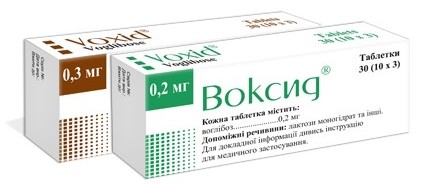
Competitive inhibitor of alpha-glucose that breaks down polysaccharides. Inhibits the formation and absorption of glucose, lowers its concentration in the blood. Does not adversely affect the activity of β-glucosidase. The drug is slowly absorbed into the bloodstream, which minimizes the risks of negative reactions, and is quickly excreted from the body with feces. It is forbidden to prescribe to patients with diabetic coma, after a complex surgical intervention and pathological conditions of the intestine.
Glitazone preparations
Medicine today uses two therapeutic agents of this group: pioglitazone and rosiglitazone.
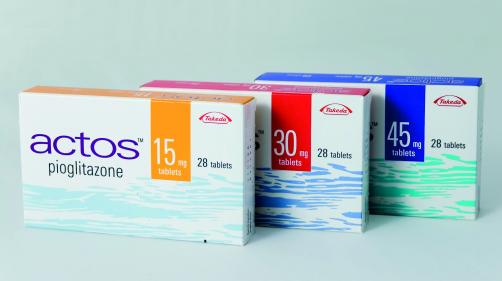
The active ingredients stimulate the receptors of muscle and adipose tissue cells, which leads to an increase in the amount of insulin produced. Peripheral tissues begin to respond better to the presence of endogenous insulin.
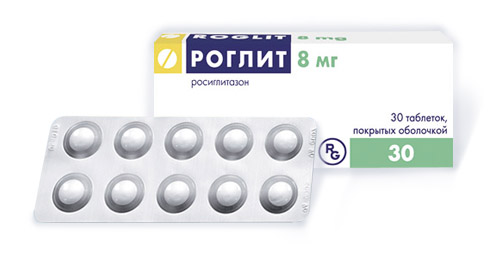
- Advantages. Considered the most effective drugs among oral medications... By blocking lipolysis in the blood, the amount of free fatty acids, the tissue will be redistributed into the subcutaneous tissue. The active ingredients increase the percentage of high-density lipoproteins, lower the level of triglycerides.
- Flaws. Negatively affect the functioning of the cardiovascular system, monotherapy lowers the physiological level of HbA1C. Long-term use can cause weight gain.
Used as monopreparations or in combination with others medical means... Sometimes they cause fluid retention in the body, anemia and abnormal liver enzymes.
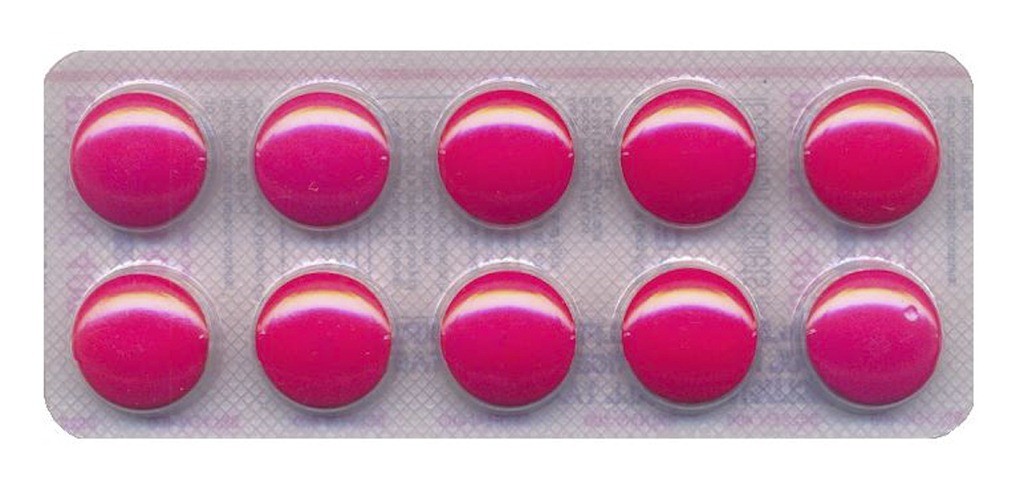
Effectively proved itself during monotherapy of overweight patients, stimulates gamma receptors. Increases the rate of glucose utilization, improves plasma concentration control. Long-term consumption at maximum doses can cause visual impairment and insomnia. Sometimes contributes to infectious diseases of the respiratory system.
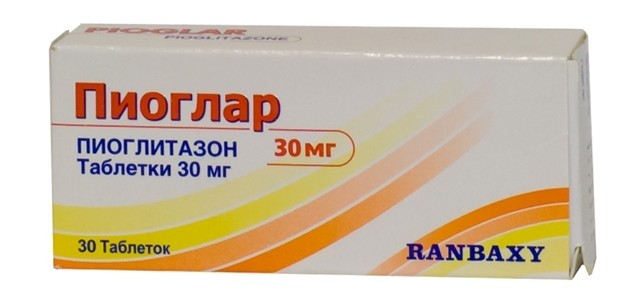
Stimulates γ-receptors involved in the process of lowering the concentration of glucose in the blood, lowers the amount of triglycerides. It has a high absorption, is excreted from the patient's body by bile, the maximum concentration in the blood is reached after 24 hours. Equilibrium concentration takes seven days. Not recommended for pregnant women and nursing mothers.
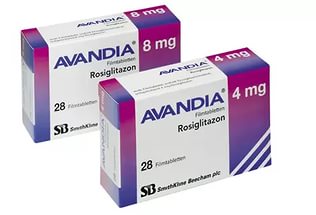
Increases the sensitivity of adipose tissue receptors to insulin, preserves and restores physiological function beta cells. Significantly lowers fatty acid levels, improves glycemic control. Do not take for patients with hypersensitivity to rosiglitazone, breastfeeding mothers and pregnant women.
Combination therapy
If monotherapy has shown its ineffectiveness even with maximum dose reception, then treatment with several drugs should be prescribed. A specific choice is made taking into account the characteristics of the course of the disease and the capabilities of the patient's body. Most often, drugs are selected that affect the increase in insulin secretion and the sensitivity of peripheral tissue. The second drug is added only after examination, while the dose of the first is not reduced.
Video - Sugar-lowering drugs for type 2 diabetes
Collapse
Effective drugs for lowering blood sugar levels are prescribed by doctors depending on what type of diabetes the patient has, what its stage, and the health status of the diabetic. It is extremely dangerous to prescribe them to yourself, since, incorrectly selected, they can have an extremely negative effect on the body. In addition, various agents are used to lower sugar, differing in composition and type of action. It is for this reason that the same drugs that lower blood sugar, in one case, act quickly and effectively, and in the other they do not have any effect at all.
Groups
The groups of hypoglycemic drugs are quite numerous. Only an endocrinologist can choose the right one based on existing analyzes and data on the patient's health. Most often, sugar-reducing drugs of the following large groups are isolated, in which, in turn, all sugar-reducing tablets and injections are divided into several more groups:
- Insulins. The group includes a single drug, insulin itself. It is mainly prescribed for type 1 diabetes. It is necessary in order to replace the natural substance that the pancreas has ceased to produce. It is pointless to use it to compensate for type 2 diabetes. Is able to lower blood sugar in a natural way;
- Glucose digestion blockers. These blood sugar lowering drugs prevent glucose from being absorbed and released into the bloodstream;
- Incretinovo - active drugs lowering sugar are able to protect beta cells;
- Secretaries. These blood sugar lowering drugs stimulate beta cells to produce their own insulin. Prescribed for type 1 diabetes, when not all beta cells are destroyed. Almost not prescribed for the second type, when insulin is normally produced, but not absorbed;
- Sugar-lowering tablets, reduce insulin resistance. Prescribed for diabetes 2 forms to increase the ability of tissues to absorb insulin and transfer glucose to cells.
All hypoglycemic drugs are varied in the type of action. They have positive and negative qualities. An experienced endocrinologist will be able to select those that will help lower blood sugar with the least side effects.
Increasing the absorption of insulin
This group includes two types of hypoglycemic drugs - biguanides and thiazolidinediones.
- Biguanides are sugar-reducing drugs such as Glukovazh, Sifor. They are inexpensive, reduce the risk of heart attack, have no effect on weight, and remove excess cholesterol. However, they cause discomfort and minor complications from the gastrointestinal tract (individual for each). Indication - type 2 diabetes;
- Thiazolidinediones (Pioglitazone) are potentially able to protect beta cells, remove "bad" cholesterol from the body, and can reduce the risk of complications on the cardiovascular system.
There are other drugs that are more or less effective in lowering blood sugar in type 2 diabetes. They do not apply to type 1 diabetics. The only therapy for them is insulin.
Secretatogi
These drugs for sugar malfunction can increase insulin secretion. Therefore, they are indicated for type 1 diabetes, when the pancreas cannot produce enough insulin. Includes two types of normalizing substances - sulfonylurea and meglitinides.
- Sulfourea is the active substance of drugs that lower blood sugar levels, such as Gliclazide MV, Glipizid. These substances from high blood sugar have positive impact fast, inexpensive, and kidney protection. However, when taking them, you should be careful, since medications that provide a sharp decrease in blood sugar sometimes provoke hypoglycemia;
- Meglitinides (Repaglinide) act quickly and prevent the onset of hyperglycemia after eating. These hypoglycemic drugs are one of the few that are suitable for people with irregular meals.
The hypoglycemic drugs of the first group are capable of depleting the pancreas, therefore, their intake must be agreed with the doctor.
Incretin-active agents
These type 2 diabetes blood sugar pills also fall into two broad groups - DPP-4 inhibitors and Peptide-1 receptor agonists. These diabetes pills work slightly differently, but can also lower blood sugar.
- Inhibitors are good because they have a minimal risk of hypoglycemia, have no effect on body weight, and have the potential to protect beta cells. These hypoglycemic drugs are sold under the names Sitagliptin, Saxagliptin. The first diabetes drug, although it lowers blood sugar, has the potential to cause pancreatitis. In addition, inhibitors are quite expensive to use in diabetes mellitus;
- Agonists are understood as antihyperglycemic drugs such as Liraglutide and Exenatide. Suitable for those looking for an answer to the question of what treatment will help you lose weight. Potentially reduces blood pressure and protects beta cells. Low risk of hypoglycemia.
Agonists are expensive and have a number of side effects. They will not lower blood sugar quickly, can cause discomfort and side effects from the gastrointestinal tract, and can also potentially contribute to the development of pancreatitis.
Blocking glucose absorption
Currently, doctors treat with only one drugs from this group - acarbose inhibitors. These drugs are high sugar in the body, block the absorption of glucose, while not increasing the likelihood of developing hypoglycemia. Side effects (especially serious ones) almost never develop, because therapy with these medicines is safe.
Of the negative qualities, the following can be distinguished:

- It is not well understood how this diabetes drug affects the cardiovascular system;
- These type 2 diabetes blood sugar lowering pills are not very effective;
- Provoke side effects from the gastrointestinal tract;
- Must be consumed three times a day.
Like therapy with other pills, these therapy is prohibited for pregnant and lactating women, people with severe diabetic decompensation, with renal and hepatic insufficiency, as well as with gastrointestinal diseases.
Contraindications
With diabetes mellitus 2 forms, it is not always possible to use hypoglycemic substances. Sometimes doctors try to find other alternatives. The prohibition on taking certain drugs by group is given below:
- Biguanides - these drugs to reduce sugar in diabetes are prohibited from prescribing for liver failure, alcoholics, pregnant and lactating women;
- Thiazolidinediones. These tablets, which lower blood sugar, should not be used for edema, heart and liver failure, and in addition, in parallel with insulin. But even in the absence of these diseases, these sugar-reducing drugs can cause cork effects - weight gain, edema. Besides, they are quite expensive;
- Sulfonated urea preparations. These hypoglycemic agents should not be taken in case of liver failure, ketoacidosis, as well as pregnant and lactating women. They can cause hypoglycemia, so if you have a tendency to surges in sugar, take them with caution;
- Meglitinides. Prohibited for admission for renal, hepatic insufficiency, decompensation of diabetes, during pregnancy and lactation. Have side effects such as the risk of hypoglycemia.
- DPP-4 inhibitors are quite expensive and not every patient can afford them. They are prohibited for use in renal, hepatic insufficiency, breastfeeding and pregnancy, decompensation;
- Peptide-1 receptor agonists should not be used to reduce blood sugar and weight while breastfeeding, expecting a baby, renal failure, liver failure, poorly compensated diabetes.
In the presence of diseases of the pancreas and the generation of insulin, taking any drug is carried out only at the discretion of the doctor. Some drugs deplete this gland and beta cells and can lead to the transition of the disease into an insulin-dependent form. Others can cause insulin resistance.
Features of reception
Most diabetics wonder how to lower sugar in the body effectively and quickly. This is possible only with regular intake and in established dosages. The doctor will help you more accurately calculate how to take pills for blood sugar and other drugs. However, there are universal rules for accepting some funds. The table below provides a list of blood sugar medications and rules for taking.
Drug intake rates
| Group | Name | Dosage | Application | Duration of action |
| Sulfonylurea | Maninil, Antibet, Glyformin, Glinil | Up to 0.02 g per day | Most effective within the first 6 hours. Begins to act in 40 minutes. Take 1 or 2 tablets daily at the discretion of your doctor | 12 hours |
| Glybenez, Antidiab | Up to 0.02 g per day | Reduce sugar in the body half an hour after ingestion. Effectively work up to 4-5 hours. It is taken twice or three times a day, which is not very convenient | 8 ocloc'k | |
| Diabeton, Diametkron | Up to 0.32 g per day | In diabetes mellitus, it begins to act 40 minutes after ingestion. The most active is 8 hours. Taken twice a day | 12 hours | |
| Biglinorm, Glurenorm |
Up to 0.12 g | Works in 40 minutes. Effective exposure time 8 hours. Number of receptions and exact dosage prescribed by the doctor | 8 ocloc'k | |
| Amaryl | Up to 0.008 g | Effective in half an hour, effective exposure time 22 hours. Take once a day | 24 hours | |
| Biguanides | Siofor, Glucophagus | Up to 2 g | They act in half an hour after ingestion (effective - 5 hours). The number of receptions and the exact dosage are prescribed by the doctor | 9 o'clock |
| Meglitinids | Novonorm | Up to 0.016 g | They act in half an hour after ingestion (effective - 4 hours). Must be taken often enough or as adjunctive therapy | 6 o'clock |
| Acarbose inhibitors | Glucobay | Up to 0.6 g | With high blood sugar, the remedy begins to act in half an hour. Effective action 14 - 24 hours. Are taken from 1 to 2 times a day at the discretion of the endocrinologist and depending on the dose | 24 hours |
| Thiazolidinediones | Aktos, Diab-norm, Amalvia | 15, 30, 45 mg (selected by a doctor) | Effective up to 16 hours. Take 1 tablet daily | 24 hours |
| Peptide-1 receptor agonists | Byetta | 5 or 10 mcg (the dosage of the injection is selected by the doctor) | Effective up to 12 hours. Are taken twice or once a day at the discretion of the endocrinologist and depending on the dose | 12 hours |
| Victose | 0.6 mg, 1.2 mg, 1.8 mg | Effectively reduce sugar in the body for up to 20 hours. Drink once a day. | 24 hours | |
| DPP inhibitors | Trajenta, Januvia, Onglisa | Up to 5 mg (Januvia - up to 100 mg) | Reception once a day in order to reduce blood sugar for a day | 24 hours |
| Galvus | 50 mg | It is taken twice a day (sometimes 1 time), effectively works for 16 hours | 24 hours |
It is most advisable to find out how to normalize blood sugar levels with a doctor. He will calculate the correct dosage, as well as select the drug that is most effective in a particular case. Do not self-medicate.
Video
Diabetes has become an incredibly common problem. After all, it is incredibly easy to disrupt the normal functioning of the pancreas. This can be due to severe stress, poor diet, lack of water drinking habit, and unhealthy lifestyles in general. Overweight people are also at risk. As a rule, in the presence of a violation of the functioning of the pancreas, the synthesis of the hormone insulin, which is necessary for the metabolism of carbohydrates, is also disrupted. More than eighty percent of people who have persistent increases in blood glucose have type 2 diabetes. Such patients, as a rule, do not need constant injections of insulin, since glycemia in this case can be controlled with the help of medicines of more convenient forms of release. There are many pills that are effective in lowering blood sugar levels. Such methods also apply to conservative treatment diabetes. More than forty different chemical formulas are used in the pharmaceutical market for the manufacture of quality drugs. Today we will look at a specific list of drugs to lower blood sugar. However, the most appropriate medication can only be prescribed by the attending physician. Don't do it yourself.
Drugs for lowering blood sugar: classification
The group of drugs under consideration is distinguished by an unprecedented assortment. That is why, for the convenience of orientation, certain subgroups of drugs were identified, each of which has a special mechanism of action.
- Secretagogues... Blood sugar lowering drugs, which belong to this group, actively help release insulin from the cells of the pancreas.
- Sensitizers... These agents increase the sensitivity of specific peripheral tissues to the effects of the hormone insulin.
- Alpha glucosidase inhibitors. Such medications interfere with the active absorption of insulin in a certain area of the gastrointestinal tract.
- have an effect on adipose tissue in human body, and also effectively enhances the formation of endogenous insulin.
Secretagogues
Well-known medicines of the considered group of medicines. They are drugs that rapidly lower blood sugar.
There are two groups of these agents: sulfonylurea derivatives and methylglinides. They differ in their mechanism of action.
The first subcategory includes the following drugs: "Gimeperide", "Glickvidone" and "Glibenclamide". Reviews report that all of these drugs for lowering blood sugar are equally effective. They activate the release of insulin into the blood, which, in turn, contributes to a significant decrease in glycemic levels. Their differences consist only in the amount of the substance included in one working dose. The disadvantage of this group: these drugs deplete the pancreas and after a while become practically ineffective. That's why traditional medicine tries to use them less and less.
- "Nateglinid". Activates the release of insulin (its first phase).
- Repaglinide. Similar to the previous medication. The only difference is in the recommended dosage (in this case, the daily dose is from ten to fourteen milligrams).
All of these drugs to lower blood sugar should be taken before meals.
Sensitizers
These medicinal substances are divided into two subgroups: biguanides and thiazolidones.
The most popular representative of the first category is the drug for lowering blood sugar "Metformin", which will be discussed in more detail later in this article. It is highly appreciated by both specialists and patients. This medication is reliable, safe, well tolerated.
The drugs of the second category include "Rosiglitazone" and "Pioglitazone". These medicines are sold in pill form. The main disadvantage of these drugs is the incredibly high risk of developing cancer (in particular, malignant tumors Bladder) in the event that the duration of use exceeds twelve months.
Alpha glucosidase inhibitors
The funds included in this group are always prescribed exclusively as part of complex therapy. One of the most popular representatives is Akarobaza. This drug inhibits the absorption of carbohydrates into gastrointestinal tract... Unpleasant side effect- flatulence. Take a tablet three times a day before meals.
New drugs to lower blood sugar
The medicines that are available today do not fully meet the needs of patients, which is why research is constantly being carried out and innovative medicines are being created.
Excellent results are demonstrated by "Liraglutide", which has a greater effect on adipose tissue and in no way depletes the pancreas. The drug is sold in the form of a pen-syringe (according to the same principle as classic insulin). The medicine should be administered subcutaneously.
Herbal remedies
Many people choose to be treated with naturopathy. Then herbal preparations that lower blood sugar come to the rescue.

Especially effective in this vein are funds that are made on the basis of the following plants:
- White mulberry (as a rule, the leaves and bark of this tree are used as raw materials - an infusion is made from them, which should be consumed four times a day).
- Cinnamon. It is recommended to take up to ten grams per day. Ground cinnamon can be added to your favorite drinks (juice, tea, water).
- Broth of oats. Useful properties possesses a decoction of grains and grain husks (in a proportion of twenty grams per four hundred milliliters of water). It should be boiled for fifteen minutes. Take four times a day before meals.
- Aspen bark. Medicines based on it are also recommended to be taken before meals.
- Blueberry. Effectively helps to reduce sugar. They use not only berries, but also leaves.
- Walnut. Preparations based on walnut partitions are good at reducing sugar. However, the course should not last longer than seven days.
- Oak acorns. The course of treatment cannot last more than one week. Acorn powder is an excellent remedy.
- Kupena (or rather, its roots). Effectively lowers blood glucose levels.
- Carnation. You can take drugs based on it or directly infusion of cloves. It should be consumed three times a day before meals.
- Burdock root.
- Nettle and rowan berries. They should be mixed in a ratio of one to two, pour boiling water over and insist for four to five hours. Take this tincture twice a day.
- Japanese sophora. Patients report the efficacy of an alcoholic tincture based on the plant in question.
- Dandelion. The infusion from the roots is popular. Also available in capsules.
- Medicinal galega.
- Leuzea.
"Januvia": instructions for use
The price of the drug is fully justified by its quality. Buyers say the drug in question is incredibly effective as an adjunct to preventive measures such as a specialized diet and certain exercise shown to patients with type 2 diabetes mellitus as measures to improve glycemic control. 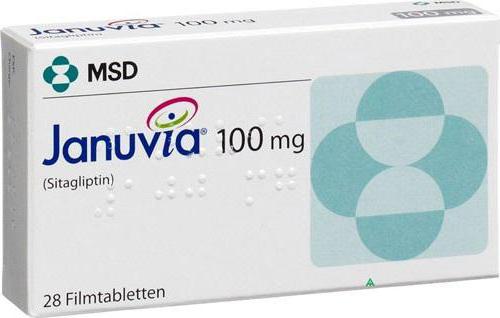
Also, experts recommend taking this medication in combination with thiazolidinedione or metformin. This method of treatment should only be used if the combination of monotherapy, diet and sports does not help keep blood glucose levels at the proper level.
The attending physicians strongly recommend that patients, before starting treatment, carefully read what the instructions for use say about Januvia. Price medicinal product the average is two thousand two hundred and eighty rubles. The cost often depends directly on which pharmacy network you decide to use.
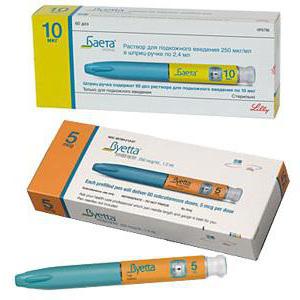
"Byeta": instructions for use
The price of the drug ranges from four and a half to eight thousand rubles.
The drug in question is prescribed for patients with type 2 diabetes. The drug is effective and how main component monotherapy, and as part of combination therapy. It is used in combination with a special diet and properly selected physical exercises.
How to use the drug? It should be injected subcutaneously into the abdomen, forearm, or thigh. The working dose is five micrograms. It should be administered twice a day at least one hour before meals. After a month, the dose is recommended to be doubled.
It is important that before starting therapy the patient has studied all the available information about the drug "Byetta": instructions for use, the price of the drug, substitutes and contraindications. This will help avoid the unpleasant consequences of therapy.
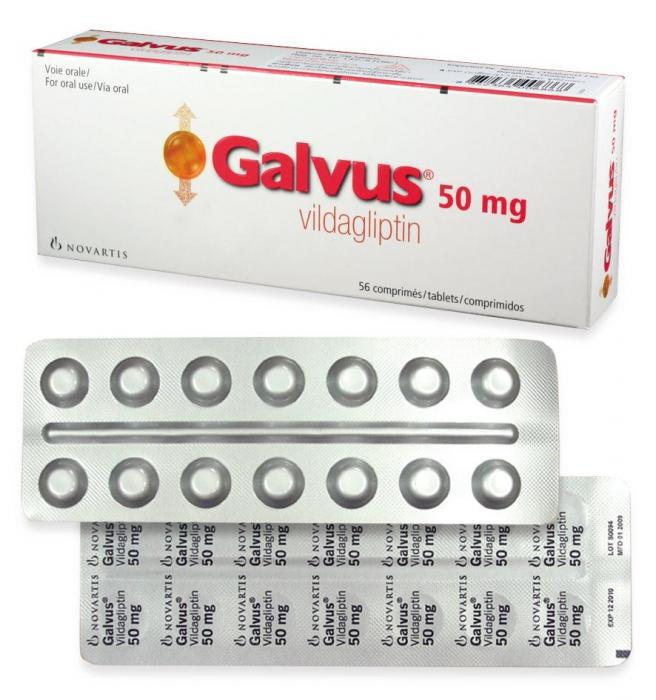
Galvus
The drug for use is called an effective hypoglycemic agent. It is actively used in type 2 diabetes mellitus.
The drug is recommended to be used in combination with a prescribed diet and special physical exercises, or in combination with medications such as Metformin, if the first treatment option has become insufficiently effective.
There are certain contraindications to the use of the agent in question. Among them: childhood(up to eighteen years old), galactose intolerance (in particular, inherited intolerance), individual hypersensitivity to one of the components medication, lack of lactase, as well as glucose-galactose malabsorption, disruption of the normal functioning of the liver.
How should the medicine be taken? The medication is taken orally, regardless of food intake. If the patient is taking insulin and metformin, then the drug is prescribed at a dose of one hundred micrograms per day. However, the exact dosage should be determined only by the attending physician who has sufficient information about the patient's health and is able to adequately assess all the available data on the Galvus medication (instructions for use, usage patterns, etc.).
"Siofor"
The main active ingredient of the drug is metamorphine hydrochloride. It is considered a powerful glucose-lowering drug belonging to the biguanide class. "Siofor" experts call the safest medication in this group of drugs, which is appropriate to use not only for treatment, but also for prevention. The drug can be both the main component of monotherapy and part of complex therapy, which includes other glucose-lowering substances. 
How quickly Siofor lowers blood sugar? It all depends on how accurately the patient adheres to the recommendations of the specialist. Before starting therapy, it is necessary to carefully examine the functioning of the kidneys and the excretory system as a whole. Such studies must be carried out every six months during treatment and for another year after its completion. Do not take iodine at the same time as a glucose-lowering drug. As well as taking the medicine for two days before the X-ray examination and for several hours after it. At the beginning of treatment, you should refrain from activities that require a good reaction and concentration.
"Metformin"
The main active ingredient of the medication in question is metformin hydrochloride. Prescribe "Metformin" for diabetes of the second degree to those patients who do not suffer from ketoacidosis (in particular, it affects people who are prone to obesity), and in the absence of the effect of diet therapy. It is sometimes used in conjunction with insulin (effective for severe obesity). 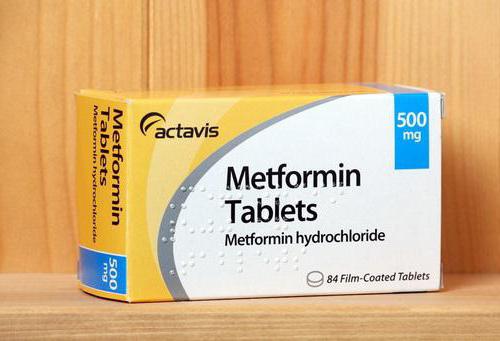
There are some contraindications to the use of the drug in question. Among them: impaired renal function, dehydration, diabetic ketoacidosis, coma, fever, diabetic precoma, alcoholism, infectious diseases, hypoxia, surgery, serious injuries, acute alcohol poisoning, liver dysfunction, period breastfeeding, myocardial infarction, X-ray studies, period of childbearing, radioisotope study, lactic acidosis, hypocaloric diet, individual intolerance to the components of the drug.
Outcome
Glycemia control should be carried out only under the constant supervision of a competent specialist and with the help of high-quality drugs. Therefore, it is important to pay due attention to the selection of the appropriate medication. Careful study of the above information will help you in this difficult task. Carefully investigate all the features of the chosen medicine before starting treatment.
Choose only high-quality drugs for yourself and your loved ones. Be healthy!
